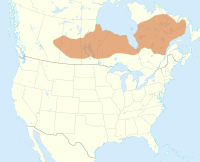Tataramon na Cree
Appearance
| Cree | |
|---|---|
| ᓀᐦᐃᔭᐍᐏᐣ, nēhiyawēwin (Plains) ᓃᐦᐃᖬᐑᐏᐣ, nīhithawīwin (Woods) ᓀᐦᐃᓇᐌᐎᐣ, nêhinawêwin (W Swampy) ᐃᓂᓃᒧᐎᓐ, ininîmowin (E Swampy) ᐃᔨᓂᐤ ᐊᔭᒥᐎᓐ, Iyiniu-Ayamiwin (N Eastern) ᐄᔨᔫ ᐊᔨᒨᓐ, Iyiyiu-Ayamiwin (S Eastern) | |
 Historical distribution of Cree peoples | |
| Subong sa | Canada; United States (Montana) |
| Subong | Cree |
Subong na mga parataram | 96,000, 27% of ethnic population (2016 census)[1] (including Montagnais–Naskapi and Atikamekw) |
Algic
| |
| Latin, Canadian Aboriginal syllabics (Cree) | |
| Opisyal na kamugtakan | |
Opisyal na tataramon sa | Plantilya:Country data Northwest Territories[3] |
Binistado kan minoridad tataramon sa | |
| Mga kodigo nin tataramon | |
| ISO 639-1 | cr |
| ISO 639-2 | cre |
| ISO 639-3 | cre – inklusibong kodigoIndibiduwal na mga kodigo: crk – Plains Creecwd – Woods Creecsw – Swampy Creecrm – Moose Creecrl – Northern East Creecrj – Southern East Creensk – Naskapimoe – Montagnaisatj – Atikamekw |
| Glotologo | cree1271 Cree–Montagnais–Naskapicree1272 |
 Six dialects of Cree are classified as Vulnerable by the UNESCO Atlas of the World's Languages in Danger | |
 Six dialects of Cree are classified as Vulnerable by the UNESCO Atlas of the World's Languages in Danger | |
An Cree /ˈkriː/[4] (midbid man bilang Cree–Montagnais–Naskapi) iyo an dialect continuum kan Algonquian languages pigtataram kan haros 117,000 mga tawo sa enterong Canada, poon sa Northwest Territories pasiring sa Alberta sagkod sa Labrador.[5] Kun konsiderasyon bilang sarong tataramon, iyo iyan an aboriginal language na igwa nin pinakahangkaw na bilang nin parataram sa Canada.[6] An solamenteng rehiyon na kun saen an Cree igwa nin official status iyo an sa Northwest Territories, kaiba an walong iba pang aboriginal languages.[7] Diyan an Cree pigtataram sa pangenot sa Fort Smith asin Hay River.[8]
Toltolan
[baguhon | baguhon an source]- ↑ "Language Highlight Tables, 2016 Census – Aboriginal mother tongue, Aboriginal language spoken most often at home and Other Aboriginal language(s) spoken regularly at home for the population excluding institutional residents of Canada, provinces and territories, 2016 Census – 100% Data". Canada Statistics. 2017-08-02. Retrieved 2017-11-22.
- ↑ Hammarström, Harald; Forkel, Robert; Haspelmath, Martin; Bank, Sebastian (2022-05-24). "Cree-Montagnais-Naskapi". Glottolog. Max Planck Institute for Evolutionary Anthropology. Archived from the original on 2022-10-15. Retrieved 2022-10-29. Unknown parameter
|url-status=ignored (help) - ↑ "Official Languages of the Northwest Territories" (PDF). Northwest Territories Language Commissioner. Archived from the original (PDF) on March 23, 2012. (map)
- ↑ Laurie Bauer (2007). The Linguistics Student's Handbook. Edinburgh.
- ↑ "Education, Culture, and Employment". Government of the Northwest Territories. Archived from the original on July 27, 2018. Retrieved October 4, 2017. Unknown parameter
|url-status=ignored (help) - ↑ "2006 Census". Statistics Canada. Archived from the original on 2013-10-16. Retrieved October 16, 2013.
- ↑ Error sa pag-cite: Imbalidong
<ref>tatak; mayong teksto na ipinagtao para sa reperensiya na pinagngaranan nalang - ↑ "2016–2017 annual report on official languages" (PDF). Government of the Northwest Territories.
Mga kategorya:
- Mga artikulo na naglalaog nin teksto sa tataramon na Plains Cree
- Mga artikulo na naglalaog nin teksto sa tataramon na Woods Cree
- Mga artikulo na naglalaog nin teksto sa tataramon na Swampy Cree
- Mga artikulo na naglalaog nin teksto sa tataramon na Northern East Cree
- Mga artikulo na naglalaog nin teksto sa tataramon na Southern East Cree
